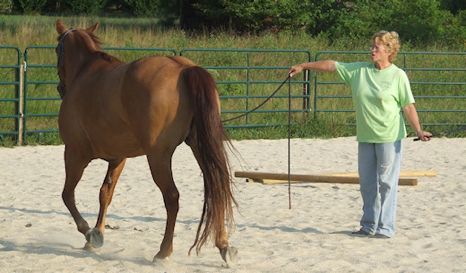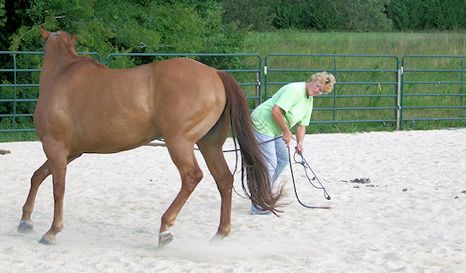A Good Grounding
Part 9: Longeing

First, a note on pronunciation and spelling: longeing is the classical and still formally correct spelling of this exercise's name, but the alternative, lungeing is becoming increasingly common. Either way, it is pronounced LUNJ-ing.
Longeing is just an extension of the Sending exercise discussed in the preceding lesson, but here you want the horse to move around you in complete circles instead of short arcs, and to yield his hindquarters and face up whenever you ask. The learning takes place in the yielding and changing of directions, not in the circling itself. This is not an exercise to tire him out, but rather to gain his respect and full attention, so once he is moving around you well, don't ask him for more than a few circuits before directing him to yield and change direction.
Stand facing your horse as in the Sending exercise, and ask him to move off in the direction of your choice. As he begins to circle you, you need to walk a smaller circle inside of and in the same direction he's circling in. Stay behind his midline and keep your eyes on his hip. Be sure you are always moving forward; if you back up you will draw your horse toward you and he will yield his hindquarters and face up, or he will turn in and come toward you, and you'll need to start over again.
Your horse should move in a nice circle around you, with slack in the line. He should not be pulling on the line. If he is, just bump him off of it by giving the line several short sharp tugs. He might want to turn in to you when you do this; if so, just ask him to keep going forward. If he turns into you and stops unbidden, don't worry about it; simply ask him to move off again.

Once your horse is moving nicely around you, ask him to yield his hindquarters and face you: slide your direction hand an arm's length up the lead (toward the halter) and pull it in to your middle while you simultaneously bend forward at the waist and take one step toward his hind end while staring hard at his rump. If more pressure than this is required to get him to yield, swing your stick or the end of the lead line toward his hip. Here, your entire body language has changed: you have gone from walking a circle while standing upright with your midline square to his girth line, to bending over, staring at his rump and stopping all forward motion. If he doesn't get it and continues to move around you, just do it again. Move your hand up the lead, bend over and step toward his tail while swinging the stick or the end of the lead line toward his hip. Each time you do this move, you are getting closer to him. He will yield his hindquarters eventually. When he does, stand calmly in front of him, about four feet away. Praise him and give him a nice rub on his face with the stick. Let him relax for a few seconds, then switch hands and ask him to move off in the opposite direction.